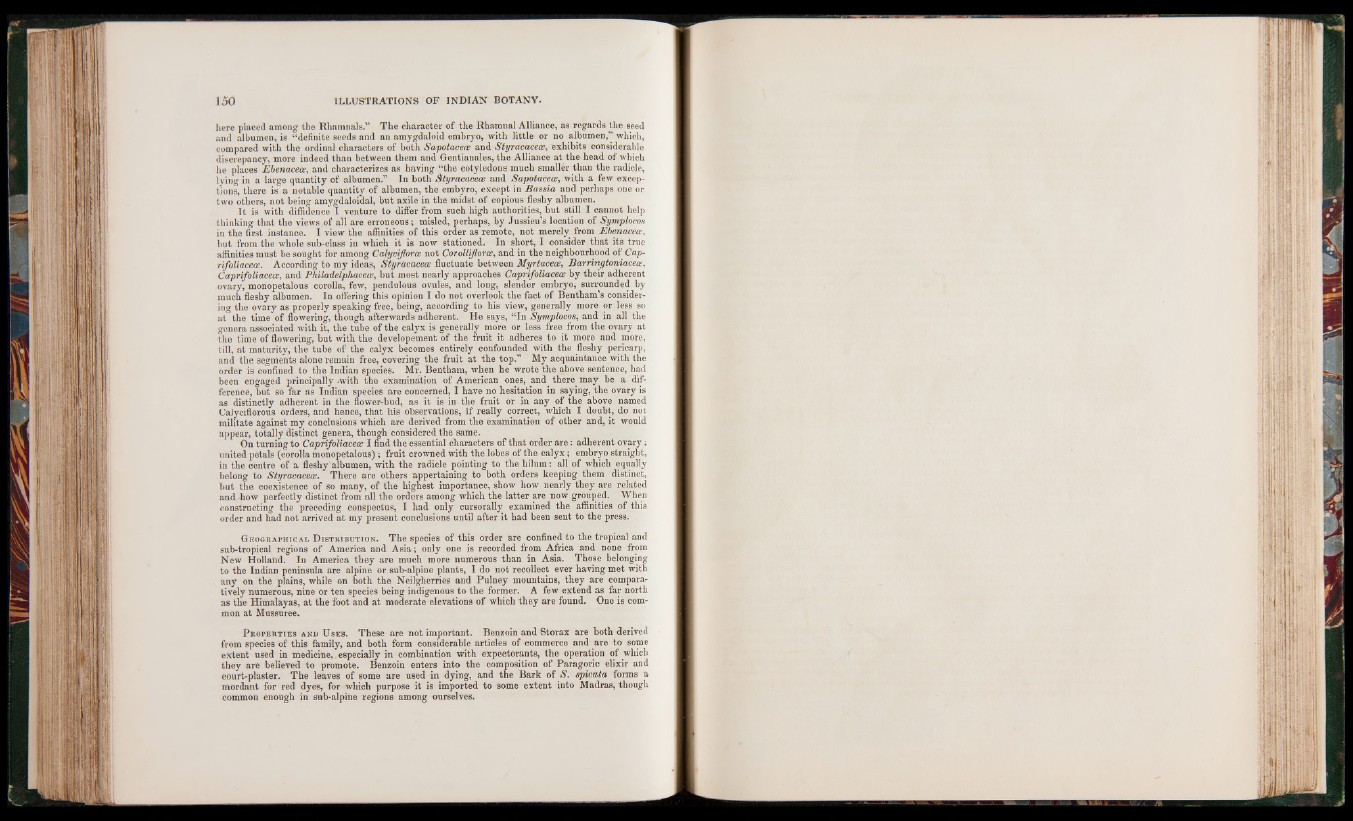
here placed among the Rhamnals.” The character of the Rhamnal Alliance, as regards the seed
and albumen, is “definite seeds and an amygdaloid embryo, with little or no albumen,” which,
compared with the ordinal characters of both Sapotacece and Styracacece, exhibits considerable
discrepancy, more indeed than between them and Gentianales, the Alliance at the head of which
he places Ebenaceoe, and characterizes as having “the cotyledons much smaller than the radicle,
lying in a large quantity of albumen.” In both Styracacece and Sapotacece, with a few exceptions,
there is a notable quantity of albumen, the embyro, except in Bassia and perhaps one or
two others, not being amygdaloidal, but axile in the midst of copious fleshy albumen.
I t is with diffidence I venture to differ from such high authorities, but still I cannot help
thinking that the views,of all are erroneous; misled, perhaps, by Jussieu’s location of Symplocos
in the first instance. I view the affinities of this order as remote, not merely from Ebenaceoe,
but from the whole sub-class in which it is now stationed. In short, I consider that its true
affinities must be sought for among Calyciflorce not Corollifiorce, and in the neighbourhood of Cap-
rifoliacece. According to my ideas, Styracacece fluctuate between Myrtacece, Barringtoniacece,
Caprifoliacece, and Philadelphacece, but most nearly approaches Caprifoliacece by their adherent
ovary, monopetalous corolla, few, pendulous ovules, and long, slender embryo, surrounded by
much fleshy albumen. In offering this opinion I do not overlook the fact of Bentham’s considering
the ovary as properly speaking free, being, according to his view, generally more or less so
at the time of flowering, though afterwards adherent. He says, “In Symplocos, and in all the
genera associated with it, the tube of the calyx is generally more or less free from the ovary at
the time of flowering, but with the developement of the fruit it adheres to it more and more,
till, at maturity, the tube of the calyx becomes entirely confounded with the fleshy pericarp,
and the segments alone remain free, covering the fruit at the top.” My acquaintance with the
order is confined to the Indian species. Mr. Bentham, when he wrote the above sentence, had
been engaged principally -with the examination of American ones, and there may be a difference,
but so far as Indian species are concerned, I have no hesitation in saying, the ovary is
as distinctly adherent in the flower-bud, as it is in the fruit or in any of the above named
Calyciflorous orders, and hence, that his observations, if really correct, which I doubt, do not
militate against my conclusions which are derived from the examination of other and, it would
appear, totally distinct genera, though considered the same.
On turning to Caprifoliacece I find the essential characters of that order are: adherent ovary;
united petals (corolla monopetalous); fruit crowned with the lobes of the calyx; embryo straight,
in the centre of a fleshy'albumen, with the radicle pointing to the hilum: all of which equally
belong to Styracacece. There are others appertaining to both orders keeping them distinct,
but the coexistence of so many, of the highest importance, show how nearly they are related
and how perfectly distinct from all the orders among which the latter are now grouped. When
constructing the preceding conspectus, I had only cursorally examined the affinities of this
order and had not arrived at my present conclusions until after it had been sent to the press.
Geographical D istribution. The species of this order are confined to the tropical and
sub-tropical regions of America and Asia; only one is recorded from Africa and none from
New Holland. In America they are much more numerous than in Asia. Those belonging
to the Indian peninsula are alpine or sub-alpine plants, I do not recollect ever having met with
any on the plains, while on both the Neilgherries and Pulney mountains, they are comparatively
numerous, nine or ten species being indigenous to the former. A few extend as far north
as the Himalayas, at the foot and at moderate elevations of which they are found. One is common
at Mussuree.
P roperties and U ses. These are not important. Benzoin and Storax are both derived
from species of this family, and both form considerable articles of commerce and are to some
extent used in medicine,, especially in combination with expectorants, the operation of which
they are believed to promote. Benzoin enters into the composition of Paragoric elixir and
court-plaster. The leaves of some are used in dying, and the Bark of S. spicata forms a
mordant for red dyes, for which purpose it is imported to some extent into Madras, though
common enough in sub-alpine regions among ourselves.